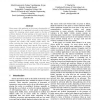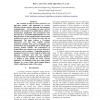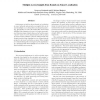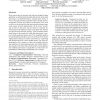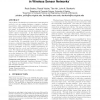HICSS
2005
IEEE
14 years 5 months ago
2005
IEEE
Wireless microsensor networks have gained great momentum due to collaborative research efforts on various disciplines. It has made many useful applications possible. In a typical ...
DSN
2005
IEEE
14 years 5 months ago
2005
IEEE
Since sensor data gathering is the primary functionality of sensor networks, it is important to provide a fault tolerant method for reasoning about sensed events in the face of ar...
DATE
2005
IEEE
14 years 5 months ago
2005
IEEE
— We introduce galsC, a language designed for programming event-driven embedded systems such as sensor networks. galsC implements the TinyGALS programming model. At the local lev...
BROADNETS
2005
IEEE
14 years 5 months ago
2005
IEEE
— Lightweight protocols that are both bandwidth and power thrifty are desirable for sensor networks. In addition, for many sensor network applications, timeliness of data deliver...
AINA
2005
IEEE
14 years 5 months ago
2005
IEEE
The Location of nodes in sensor network is an important problem with application in resource allocation, location sensitive browsing, and emergency communications. A key problem i...
WOWMOM
2006
ACM
14 years 5 months ago
2006
ACM
In this paper, we build on known bounds on localization in sensor networks and provide new insights that can be used in multiple-access design from a localization perspective. Spe...
SIGCSE
2006
ACM
14 years 5 months ago
2006
ACM
Target tracking is one of the most important applications of wireless sensor networks. Optimized computation and energy dissipation are critical requirements to maximize the lifet...
SENSYS
2006
ACM
14 years 5 months ago
2006
ACM
Most sensor network research and software design has been guided by an architectural principle that permits multi-node data fusion on small-form-factor, resource-poor nodes, or mo...
SENSYS
2006
ACM
14 years 5 months ago
2006
ACM
Introducing mobile data sinks into wireless sensor networks (WSNs) improves the energy efficiency and the network lifetime, and is demanded for many application scenarios, such a...
SENSYS
2006
ACM
14 years 5 months ago
2006
ACM
The problem of localization in wireless sensor networks where nodes do not use ranging hardware, remains a challenging problem, when considering the required location accuracy, en...

